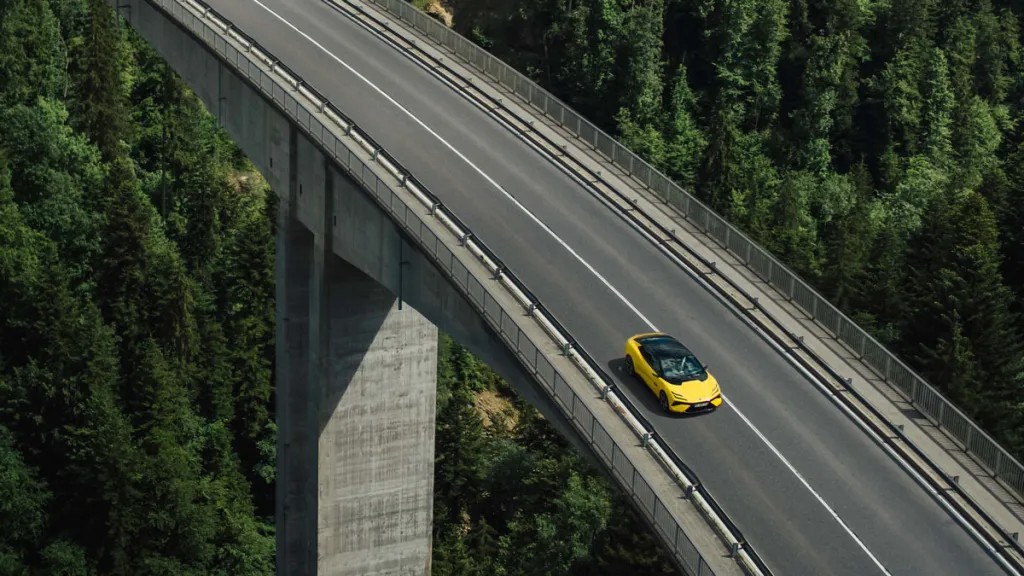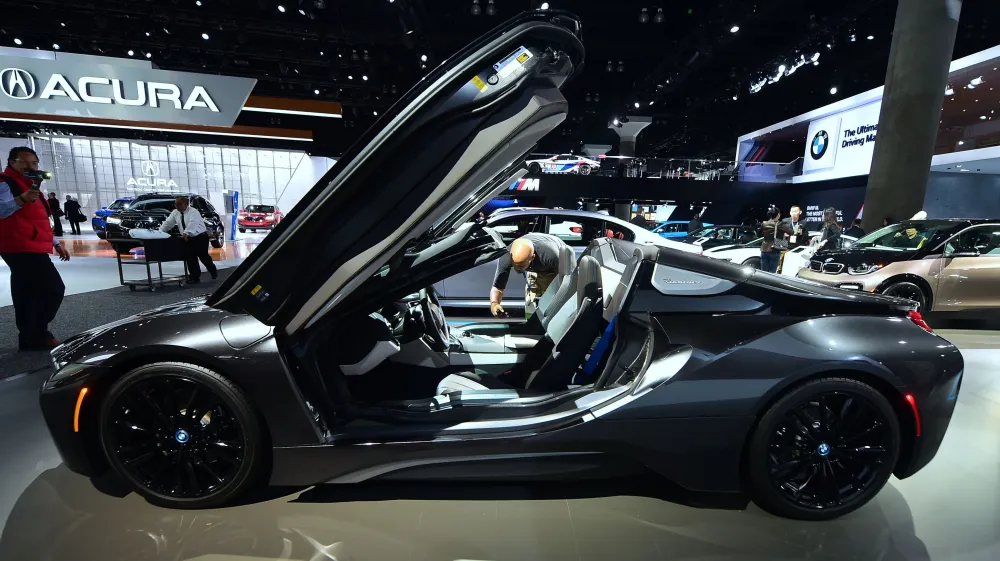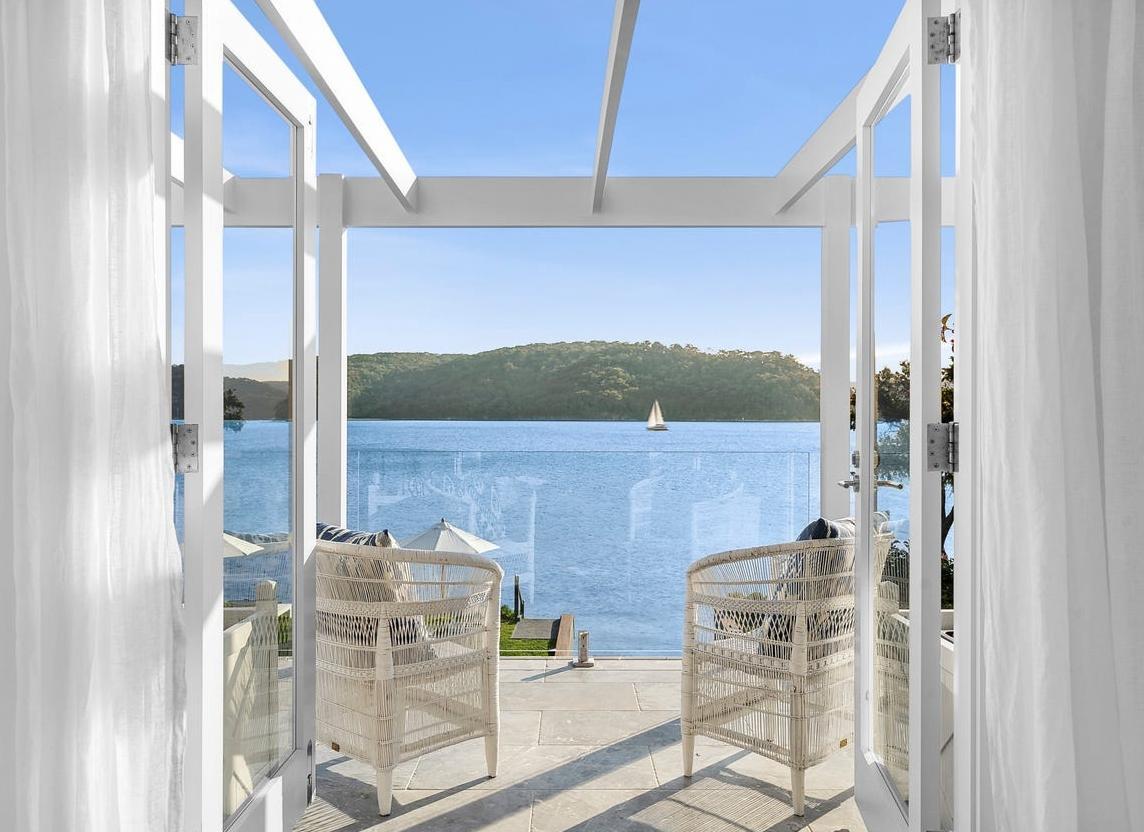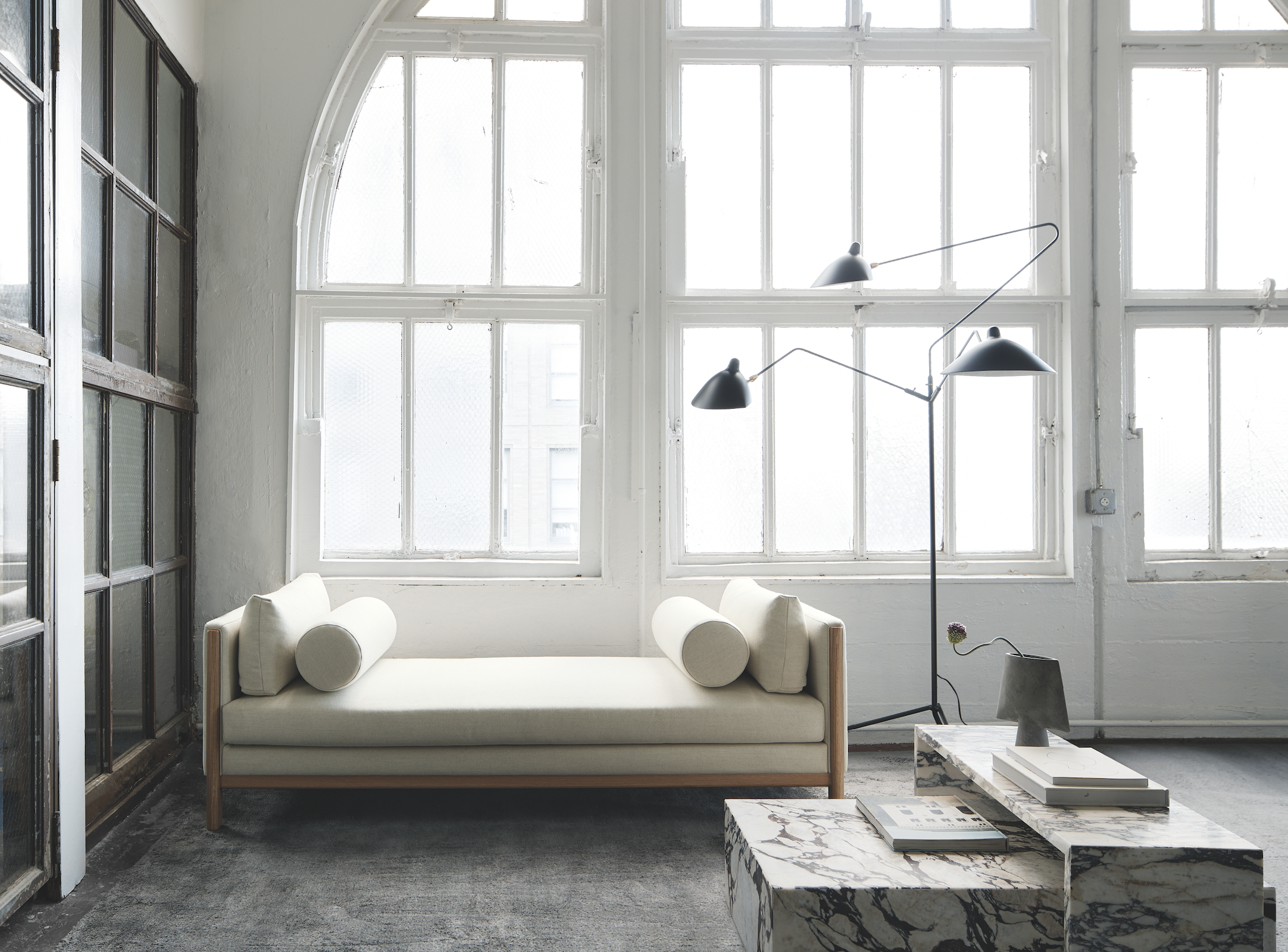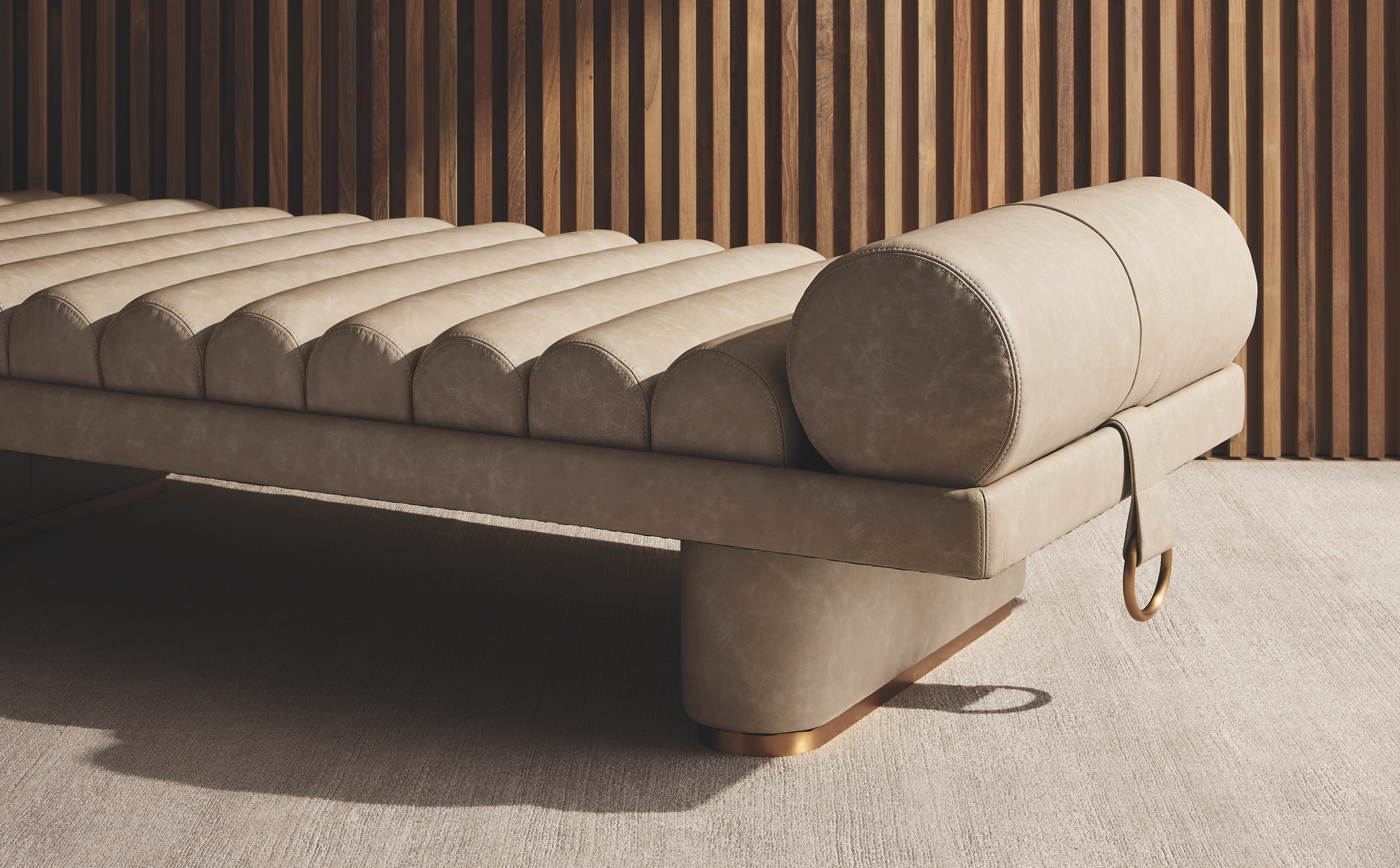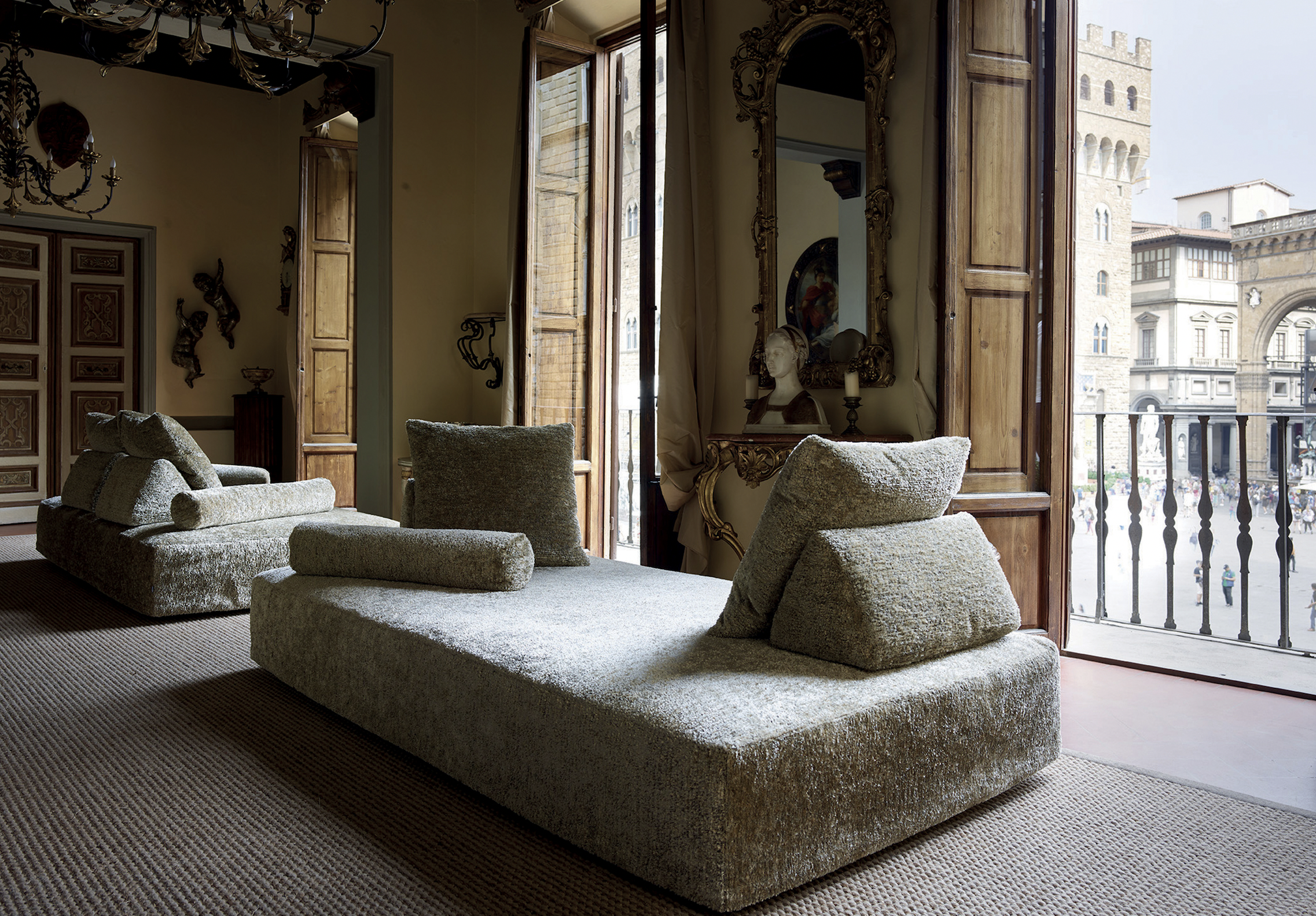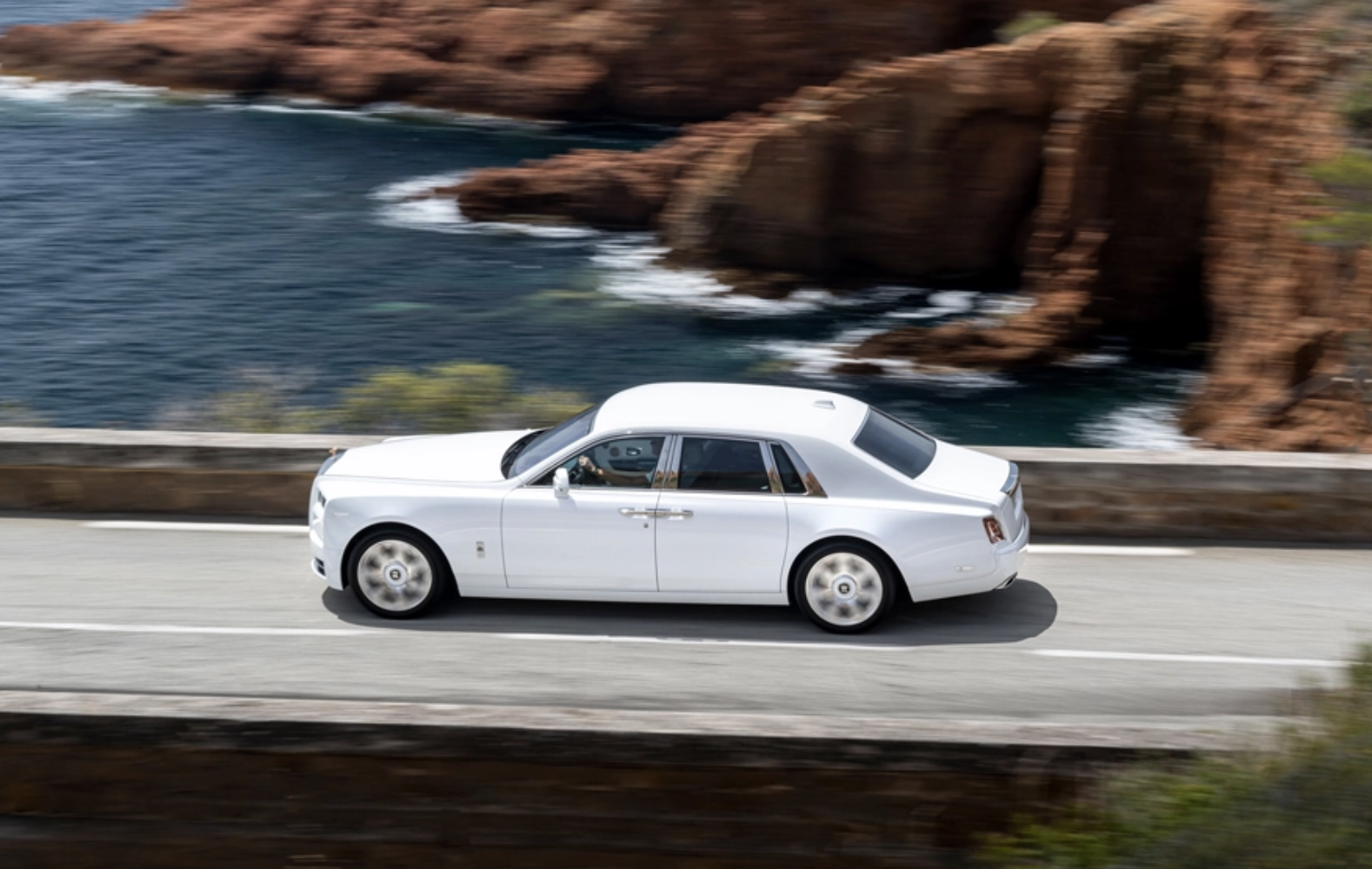
First Drive: Rolls-Royce Phantom Series II
On the roads of the French Riviera, we pilot the aesthetically enhanced model and have never been so pampered.
Related articles
When pressed to call out a product that represents the pinnacle of luxury, one often precedes the pronouncement with “the Rolls-Royce of.” The reference is hardly new. The British marque’s reputation was duly noted as far back as 1907, when the British publication Autocar called Rolls-Royce the “best car in the world.” Arguably, that title, bestowed 115 years ago, remains relevant, as evidenced by our experience with the automaker’s new 2023 Phantom Series II.
The flagship of Rolls-Royce Motor Cars since 1925, and now in its eighth generation, Phantom is the longest continuously running nameplate in the automotive industry—as forward looking and thoroughly modern as it is historically informed. For Rolls-Royce, there is no other way to build a Phantom. Its creators chose to launch the “Rolls-Royce of Rolls-Royces” (our words, not theirs) with a first global drive at the Maybourne Riviera, a brand-new, five-star hotel in Roquebrune-Cap-Martin, perched on a hilltop within shouting distance of Monte Carlo. The crisp, clean architecture and tranquil lawns made it the ideal venue at which to reveal 10 colourful Phantoms, each one a unique commission designed to showcase the near-unlimited capabilities for customisation.

The Iconoclast, one of the 10 debut examples of the Phantom Series II. James Lipman, courtesy of Rolls-Royce Motor Cars.
e Phantom Series II, in all its singular expressions. The region of Nice was a favourite part of the world for the most notable artists of the 20th century. Here, Picasso, Matisse, Chagall and dozens of other painters, sculptors, writers and thinkers revelled in the sky, the landscape and the casual lifestyle that artfully inspired each one in a different way. Like those artists, what Rolls-Royce calls the “Poles of Luxury” are ten cars with names like Maverick and Connoisseur. Between these extremes were Platino, Patriot, Founder, Iconoclast, Prodigy, Sentimentalist, Extrovert and Aristocrat.
Sophie Weekes, Bespoke Lead on Phantom Series II, explained that, “Each of these ‘10 Exemplars’ exudes its own distinctive character. Our designers work with clients to develop a deep knowledge and understanding of our customers’ personality and then express that through their commission.” Indeed, the Phantom Series II is the ideal automotive canvas on which an owner can explore new colours and combinations of materials, fabrics and finishes to paint a masterpiece as individual as it is exquisite.

The Iconoclast example’s radiant interior complements the lights of Monte Carlo below. James Lipman, courtesy of Rolls-Royce Motor Cars.
Rolls-Royce Motor Cars, under the aegis of BMW but fully autonomous, reinvented itself with the Phantom VII in 2003. It was a car that charted the company’s course for the 21st century, and was succeeded in 2017 by the Phantom VIII. But the Phantom—and Phantom owners—do not embrace radical changes, and so the Series II incorporates the most subtle aesthetic and technological enhancements that reflect the input of clients.
Astute observers would need to see the new car and its predecessor side by side to recognize the changes. In the front, a polished horizontal line connects the daytime running lights above the classic Pantheon Grille, while the “RR” badge and Spirit of Ecstasy hood ornament are more prominent as well.

The Sentimentalist commission catching the last light of day in Monte Carlo. James Lipman, courtesy of Rolls-Royce Motor Cars.
Felix Kibertus, Rolls-Royce’s head of exterior design, took a holistic approach to the lighting. “The grille itself is now illuminated, while the headlights are graced with intricate laser-cut bezel starlights, creating a visual connection with the Starlight Headliner inside. This concept which we call ‘light touch’ adds further surprise and delight to Phantom’s nighttime presence, and we see tremendous opportunities to continue to push our creative ideas.”
Day or night, the car’s profile emulates the formal proportions of every Phantom throughout history, with short front and long rear overhangs, and a long wheelbase in between. That long wheelbase can be made even longer in the Phantom Extended, the likely choice for owners wishing to be chauffeured. A high shoulder and wide C-pillars afford privacy for rear-seat occupants. Polished exterior brightwork is a feature of the Phantom design, but in response to client requests, both the grill and exterior trim are now available in darkened chrome.

The rear passenger compartment in the Series II example named the Prodigy. James Lipman, courtesy of Rolls-Royce Motor Cars.
Perhaps the most apparent new exterior design cues are the wheels, whose triangular facets are 3-D milled from solid stainless and offered in a polished, paint or chrome finish. Optional stainless 22-inch disc wheels are a tip of the hat to those on the very first Phantom, and are polished or available in a black lacquer finish.
Project Manager Ralf Langmeier enumerated some of the engineering and production challenges, saying, “To produce a fully polished version takes 60.6 hours per wheel, mainly as a result of the multiple polishing finishes. On the issue of heat, we specify that the heat dispersion rating of the brake fluid is slightly higher than with other Phantom wheels. Also, we have designed the openings to optimize airflow between the 20 [hidden] spokes. This took a number of simulations to find the ultimate size, angle and position to ensure that performance remains.”

Perhaps the most apparent new exterior design cues are the wheels, whose triangular facets are 3-D milled from solid stainless. James Lipman, courtesy of Rolls-Royce Motor Cars.
Because today’s Rolls-Royce owners are a tech-enabled crowd, the new Phantom Series II incorporates “Rolls-Royce Connected,” which communicates with Whispers, a Rolls-Royce private-members’ App. This preloads navigation instructions, displays the car’s location, security status and other information to a mobile device when the owner is away from the vehicle. And when they do enter through the wide “coach doors,” they encounter as comfortable an environment as one can imagine—at least on four wheels.
Front passengers enjoy opulent seating, separated by a wide center console, but apart from a thicker steering wheel, the cabin remains almost otherwise unchanged. In the past, clients might have assumed that a Ponderosa’s worth of leather and acres of burl would swath the interior, but today’s Rolls-Royce customers—whose average age is 45—appreciate other materials and finishes, including fabrics in wool, silk and even bamboo-based fibers. Embossing patterns and hand-painting fabrics and surfaces are also not out of the question for the artisans at the marque’s headquarters and production facility in Goodwood, England. All that is required is a creative idea, an artful solution and time.

The optional 22-inch disc wheels are a tip of the hat to those on the very first Phantom. James Lipman, courtesy of Rolls-Royce Motor Cars.
The Phantom Series II’s most arresting interior feature is the Gallery, a glass-encased expanse across the dash that can contain a custom design of the client’s choosing. Recent displays have included cloisonné butterflies, porcelain roses, bas reliefs replicating a client’s DNA and paintings commissioned from favourite artists.
Driving the Phantom is the quintessential luxury-car experience. Both front and rear occupants enjoy what Rolls-Royce designers call a “magic carpet ride,” one as soft and compliant as it is silent and smooth. The famous Ogilvy headline written in 1958 remains true that, “At 100km/h an hour, the loudest noise comes from the electric clock.” Thanks to more than 100kg of sound insulation and tyres that use a layer of foam inside to lower cabin noise by as much as 9 dB, wind and road noise is greatly attenuated, while the engine and exhaust sound are distant reminders that one is underway.

According to Rolls-Royce’s head of exterior design, “the headlights are graced with intricate laser-cut bezel starlights, creating a visual connection with the Starlight Headliner inside.” James Lipman, courtesy of Rolls-Royce Motor Cars.
That engine is the same 6.7-litre, twin-turbocharged V-12 from the previous Phantom VIII, making 420kW at 5,000 rpm and 900Nm of torque at just 1,700 rpm. In other words, as the old Rolls-Royce ads used to say, power is “Adequate.” Actually, power, and especially torque, are obscenely adequate, delivered to the rear wheels through an eight-speed automatic transmission shifted with the aid of GPS that pinpoints the car’s location, computes speed (which is limited to 250km/h) and optimises gearing based on the road ahead.
The wafting ride of the Phantom is underpinned by self-levelling air suspension, fine-tuned by a camera-aided “Flagbearer” system that scans the road to preconfigure spring and damper rates based on road conditions. Tipping the scales at a little less than 5,800 pounds, the Phantom Series II is no lightweight, but that heft is judiciously managed, thanks to Rolls-Royce’s modular aluminium space-frame chassis that is stiffer and lighter than steel. Most of the body is aluminium as well. That modular architecture will lay the foundation of every future Rolls-Royce, regardless of its motive power. It’s no secret that Spectre, the automaker’s electric coupe to be unveiled later this year, is a harbinger of things to come. With that, some speculate that the Phantom Series II may be the penultimate—or even final—V-12-powered Phantom. Whichever it is, we say, “Savor the moment.”

The “RR” badge and Spirit of Ecstasy hood ornament feature more prominently on the latest Phantom. James Lipman, courtesy of Rolls-Royce Motor Cars.
And savour, we do. Leaving our hotel, we hit the motorway and soon exit onto serpentine mountain roads toward the picturesque village of Gourdon, sharing narrow lanes with dozens of indefatigable bicyclists. The Phantom has the uncanny ability to “shrink” when pressed into athletic moves, its handling dynamics akin to a sports sedan with a little meat on its bones. Acceleration is stupendous, but so too is the braking. And the steering is quick and offers plenty of feedback.
With sure-footed precision, the Phantom negotiates tight turns at speed—some with precipitous drops on the right. Much of the deft handling is due to four-wheel steering that aids maneuverability below 60km/h and improves stability above 80km/h. In short, this is a delightful driver’s car. It’s also the perfect car in which to be driven, as I discover during a stint as rear passenger.

The Gallery display inside the Phantom Series II example known as the Sentimentalist. James Lipman, courtesy of Rolls-Royce Motor Cars.
Our destination is Saint-Paul de Vence, one of the most perfectly preserved medieval towns on the French Riviera. Situated on the crest of a hill, it was frequented by artists like Picasso, Miró and Matisse, whose paintings hang in the Café de la Place, a small restaurant attached to La’Colombe d’Or. Marc Chagall is buried in the cemetery up the hill. Nearby, the gardens of the Fondation Maeght are filled with sculpture, and its galleries contain one of Europe’s largest private collections of modern art, including important work by Giacometti, Miró, Braque and Chagall. Each of these artists was connected by the period and the place, yet each was unique, not unlike every personalised Phantom Series II, the base model of which starts at $475,000. It should be noted that, with exclusive options, each commission might require a year or more to build. But then, creating art takes time.
Subscribe to the Newsletter
Recommended for you
First Drive: The Lotus Emeya Targets Porsche, Mercedes, and Lucid With Its 70 kw Performance
What the all-electric sedan lacks in cohesive styling is more than made up for in muscular athleticism.
By Tim Pitt
July 22, 2024
Why BMW’s First Electric Cars Are Future Classics
Many things still feel contemporary about the BMW i3 and i8.
July 11, 2024
You may also like.
By Josh Bozin
24/07/2024
You may also like.
5 Lounge Chairs That Add Chic Seating to Your Space
Daybeds, the most relaxed of seating solutions, offer a surprising amount of utility.
Chaise longue, daybed, recamier, duchesse brisée—elongated furniture designed for relaxing has a roster of fancy names. While the French royal court of Louis XIV brought such pieces to prominence in fashionable European homes, the general idea has been around far longer: The Egyptian pharaohs were big fans, while daybeds from China’s Ming dynasty spurred all those Hollywood Regency fretwork pieces that still populate Palm Beach living rooms. Even Mies van der Rohe, one of design’s modernist icons, got into the lounge game with his Barcelona couch, a study of line and form that holds up today.
But don’t get caught up in who invented them, or what to call them. Instead, consider their versatility: Backless models are ideal in front of large expanses of glass (imagine lazing on one with an ocean view) or at the foot of a bed, while more structured pieces can transform any corner into a cozy reading nook. Daybeds may be inextricably linked to relaxation, but from a design perspective, they put in serious work.
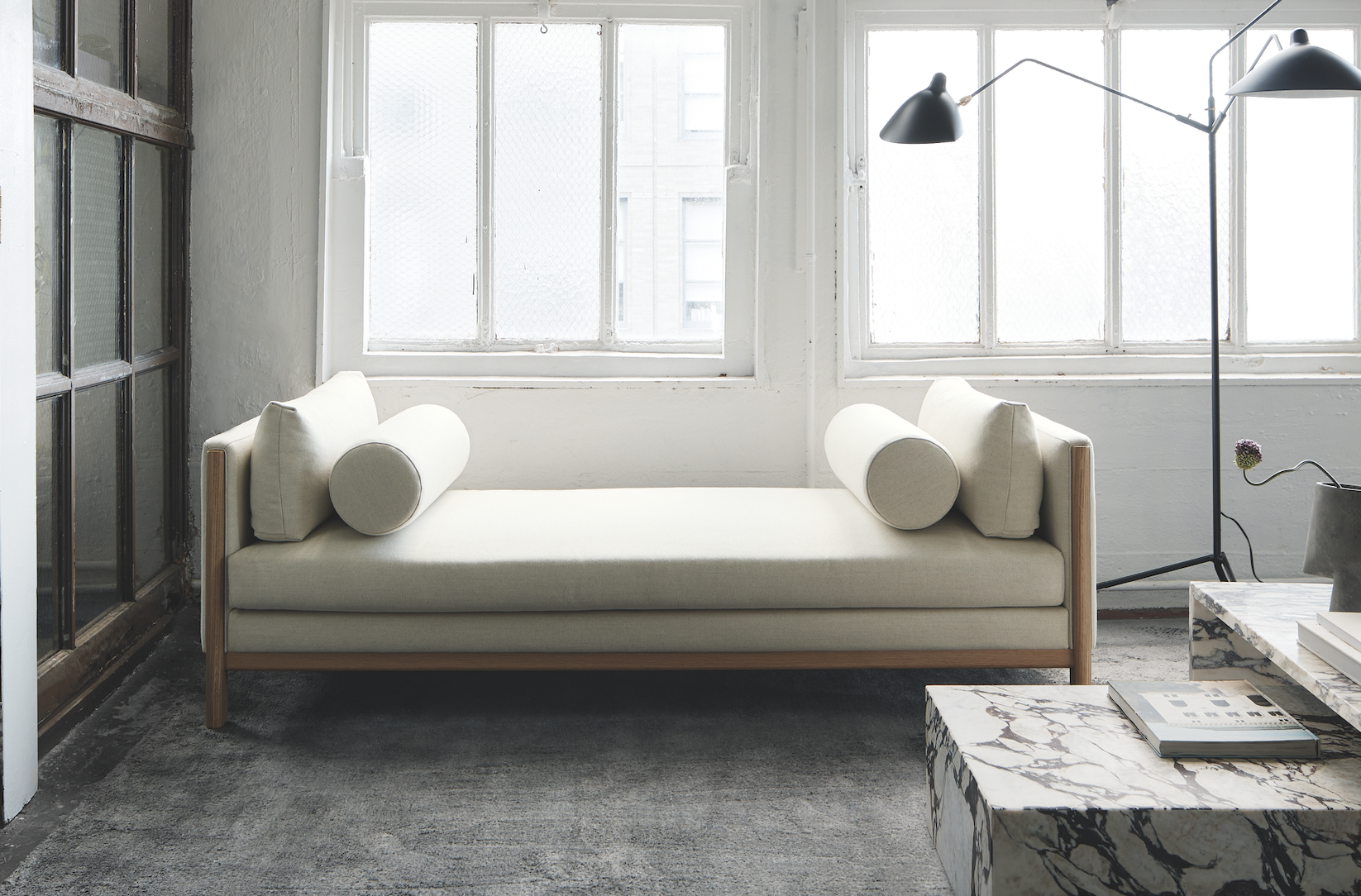
Emmy, Egg Collective
In designing the Emmy chaise, the Egg Collective trio of Stephanie Beamer, Crystal Ellis and Hillary Petrie, who met as students at Washington University in St. Louis, aimed for versatility. Indeed, the tailored chaise looks equally at home in a glass skyscraper as it does in a turn-of-the-century town house. Combining the elegance of a smooth, solid oak or walnut frame with the comfort of bolsters and cushioned upholstery or leather, it works just as well against a wall or at the heart of a room. From around $7,015; Eggcollective.com
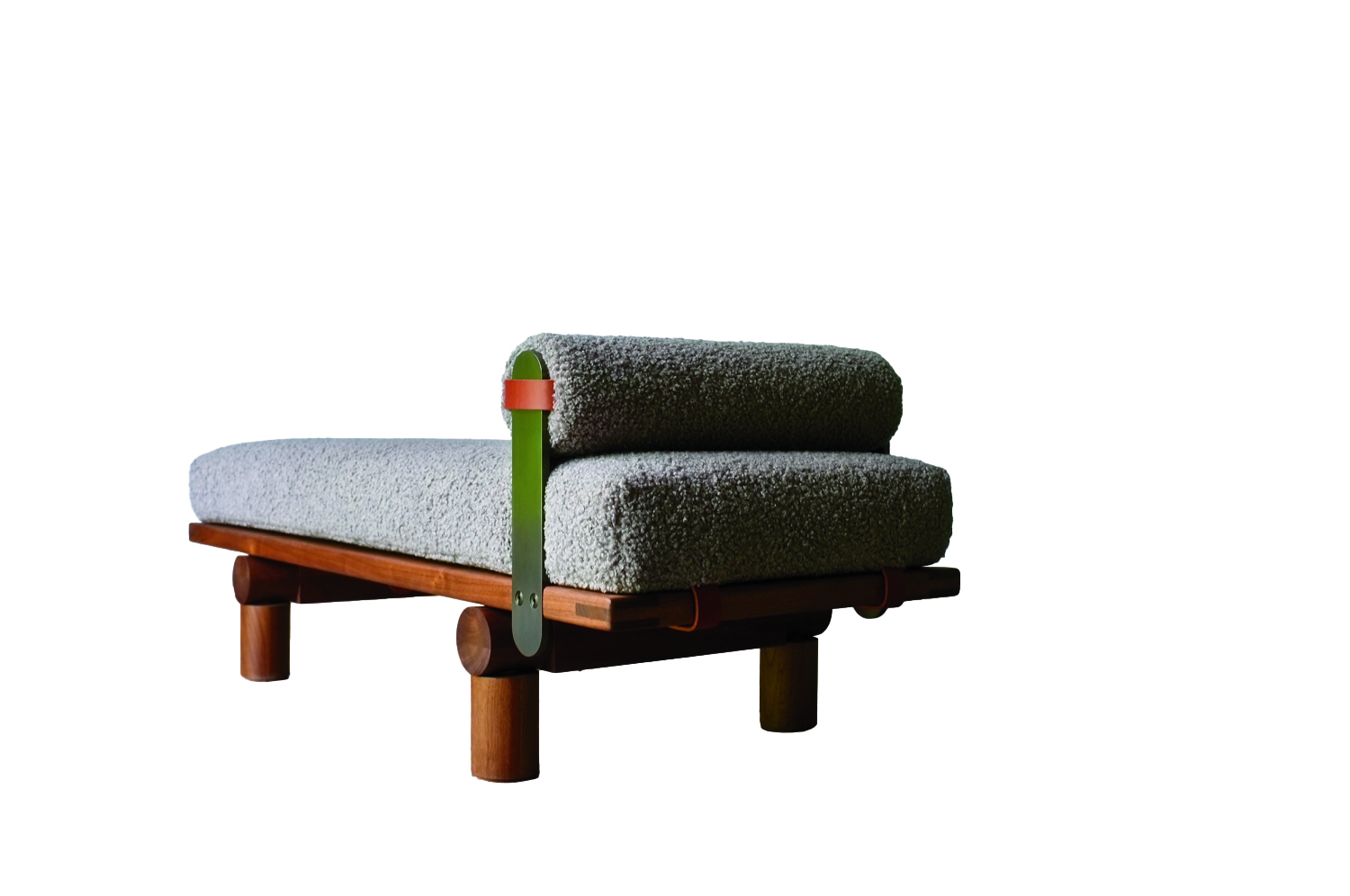 Plum, Michael Robbins
Plum, Michael Robbins
Woodworker Michael Robbins is the quintessential artisan from New York State’s Hudson Valley in that both his materials and methods pay homage to the area. In fact, he describes his style as “honest, playful, elegant and reflective of the aesthetic of the Hudson Valley surroundings”. Robbins crafts his furniture by hand but allows the wood he uses to help guide the look of a piece. (The studio offers eight standard finishes.) The Plum daybed, brought to life at Robbins’s workshop, exhibits his signature modern rusticity injected with a hint of whimsy thanks to the simplicity of its geometric forms. Around $4,275; MichaelRobbins.com
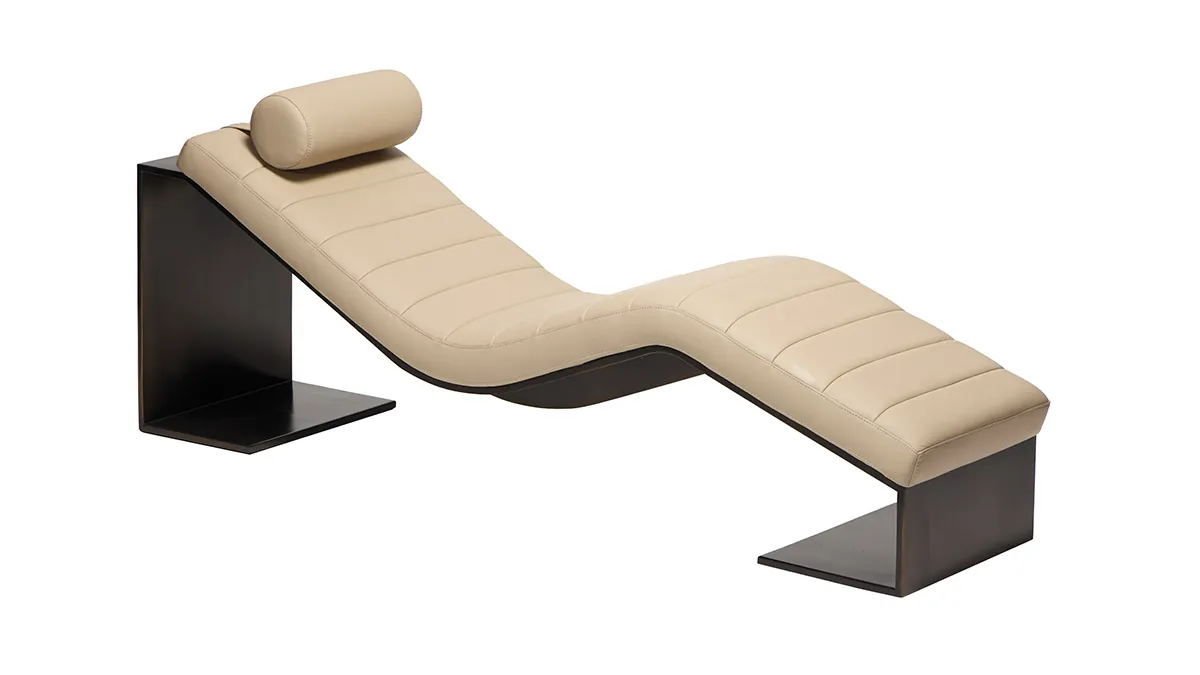
Kimani, Reda Amalou Design
French architect and designer Reda Amalou acknowledges the challenge of creating standout seating given the number of iconic 20th-century examples already in existence. Still, he persists—and prevails. The Kimani, a bent slash of a daybed in a limited edition of eight pieces, makes a forceful statement. Its leather cushion features a rolled headrest and rhythmic channel stitching reminiscent of that found on the seats of ’70s cars; visually, these elements anchor the slender silhouette atop a patinated bronze base with a sure-handed single line. The result: a seamless contour for the body. Around $33,530; RedaAmalou
Dune, Workshop/APD
From a firm known for crafting subtle but luxurious architecture and interiors, Workshop/APD’s debut furniture collection is on point. Among its offerings is the leather-wrapped Dune daybed. With classical and Art Deco influences, its cylindrical bolsters are a tactile celebration, and the peek of the curved satin-brass base makes for a sensual surprise. Associate principal Andrew Kline notes that the daybed adeptly bridges two seating areas in a roomy living space or can sit, bench-style, at the foot of a bed. From $13,040; Workshop/ APD
Sherazade, Edra
Designed by Francesco Binfaré, this sculptural, minimalist daybed—inspired by the rugs used by Eastern civilizations—allows for complete relaxation. Strength combined with comfort is the name of the game here. The Sherazade’s structure is made from light but sturdy honeycomb wood, while next-gen Gellyfoam and synthetic wadding aid repose. True to Edra’s amorphous design codes, it can switch configurations depending on the user’s mood or needs; for example, the accompanying extra pillows—one rectangular and one cylinder shaped— interchange to become armrests or backrests. From $32,900; Edra
You may also like.
By Josh Bozin
24/07/2024
22/07/2024
Watches & Wonders 2024 Showcase: Hermès
We head to Geneva for the Watches & Wonders exhibition; a week-long horological blockbuster featuring the hottest new drops, and no shortage of hype.
With Watches & Wonders 2024 well and truly behind us, we review some of the novelties Hermès presented at this year’s event.
—
HERMÈS

Moving away from the block colours and sporty aesthetic that has defined Hermès watches in recent years, the biggest news from the French luxury goods company at Watches & Wonders came with the unveiling of its newest collection, the Hermès Cut.
It flaunts a round bezel, but the case middle is nearer to a tonneau shape—a relatively simple design that, despite attracting flak from some watch aficionados, works. While marketed as a “women’s watch”, the Cut has universal appeal thanks to its elegant package and proportions. It moves away from the Maison’s penchant for a style-first product; it’s a watch that tells the time, not a fashion accessory with the ability to tell the time.
Hermès gets the proportions just right thanks to a satin-brushed and polished 36 mm case, PVD-treated Arabic numerals, and clean-cut edges that further accentuate its character. One of the key design elements is the positioning of the crown, boldly sitting at half-past one and embellished with a lacquered or engraved “H”, clearly stamping its originality. The watch is powered by a Hermès Manufacture movement H1912, revealed through its sapphire crystal caseback. In addition to its seamlessly integrated and easy-wearing metal bracelet, the Cut also comes with the option for a range of coloured rubber straps. Together with its clever interchangeable system, it’s a cinch to swap out its look.
It will be interesting to see how the Hermès Cut fares in coming months, particularly as it tries to establish its own identity separate from the more aggressive, but widely popular, Ho8 collection. Either way, the company is now a serious part of the dialogue around the concept of time.
—
Read more about this year’s Watches & Wonders exhibition at robbreport.com.au
You may also like.
22/07/2024
Living La Vida Lagerfeld
The world remembers him for fashion. But as a new tome reveals, the iconoclastic designer is defined as much by extravagant, often fantastical, homes as he is clothes.
“Lives, like novels, are made up of chapters”, the world-renowned bibliophile, Karl Lagerfeld, once observed.
Were a psychological-style novel ever to be written about Karl Lagerfeld’s life, it would no doubt give less narrative weight to the story of his reinvigoration of staid fashion houses like Chloe, Fendi and Chanel than to the underpinning leitmotif of the designer’s constant reinvention of himself.
In a lifetime spanning two centuries, Lagerfeld made and dropped an ever-changing parade of close friends, muses, collaborators and ambiguous lovers, as easily as he changed his clothes, his furniture… even his body. Each chapter of this book would be set against the backdrop of one of his series of apartments, houses and villas, whose often wildly divergent but always ultra-luxurious décor reflected the ever-evolving personas of this compulsively public but ultimately enigmatic man.
With the publication of Karl Lagerfeld: A Life in Houses these wildly disparate but always exquisite interiors are presented for the first time together as a chronological body of work. The book indeed serves as a kind of visual novel, documenting the domestic dreamscapes in which the iconic designer played out his many lives, while also making a strong case that Lagerfeld’s impact on contemporary interior design is just as important, if not more so, than his influence on fashion.

In fact, when the first Lagerfeld interior was featured in a 1968 spread for L’OEil magazine, the editorial describes him merely as a “stylist”. The photographs of the apartment in an 18th-century mansion on rue de Université, show walls lined with plum-coloured rice paper, or lacquered deepest chocolate brown in sharp contrast to crisp, white low ceilings that accentuated the horizontality that was fashionable among the extremely fashionable at the time. Yet amid this setting of aggressively au courant modernism, the anachronistic pops of Art Nouveau and Art Deco objects foreshadow the young Karl’s innate gift for creating strikingly original environments whose harmony is achieved through the deft interplay of contrasting styles and contexts.
Lagerfeld learned early on that presenting himself in a succession of gem-like domestic settings was good for crafting his image. But Lagerfeld’s houses not only provided him with publicity, they also gave him an excuse to indulge in his greatest passion. Shopping!
By 1973, Lagerfeld was living in a new apartment at Place Saint–Sulpice where his acquisition of important Art Deco treasures continued unabated. Now a bearded and muscular disco dandy, he could most often be found in the louche company of the models, starlets and assorted hedonistic beauties that gathered around the flamboyant fashion illustrator Antonio Lopez. Lagerfeld was also in the throes of a hopeless love affair with Jacques de Bascher whose favours he reluctantly shared with his nemesis Yves Saint Laurent.

He painted the rooms milky white and lined them with specially commissioned carpets—the tawny patterned striations of which invoked musky wild animal pelts. These lent a stark relief to the sleek, machine-age chrome lines of his Deco furnishings. To contemporary eyes it remains a strikingly original arrangement that subtly conveys the tensions at play in Lagerfeld’s own life: the cocaine fuelled orgies of his lover and friends, hosted in the pristine home of a man who claimed that “a bed is for one person”.
In 1975, a painful falling out with his beloved Jacques, who was descending into the abyss of addiction, saw almost his entire collection of peerless Art Deco furniture, paintings and objects put under the auctioneer’s hammer. This was the first of many auction sales, as he habitually shed the contents of his houses along with whatever incarnation of himself had lived there. Lagerfeld was dispassionate about parting with these precious goods. “It’s collecting that’s fun, not owning,” he said. And the reality for a collector on such a Renaissance scale, is that to continue buying, Lagerfeld had to sell.
Of all his residences, it was the 1977 purchase of Hôtel Pozzo di Borgo, a grand and beautifully preserved 18th-century house, that would finally allow him to fulfill his childhood fantasies of life in the court of Madame de Pompadour. And it was in this aura of Rococó splendour that the fashion designer began to affect, along with his tailored three-piece suits, a courtier’s ponytailed and powdered coif and a coquettish antique fan: marking the beginning of his transformation into a living, breathing global brand that even those with little interest in fashion would immediately recognise.
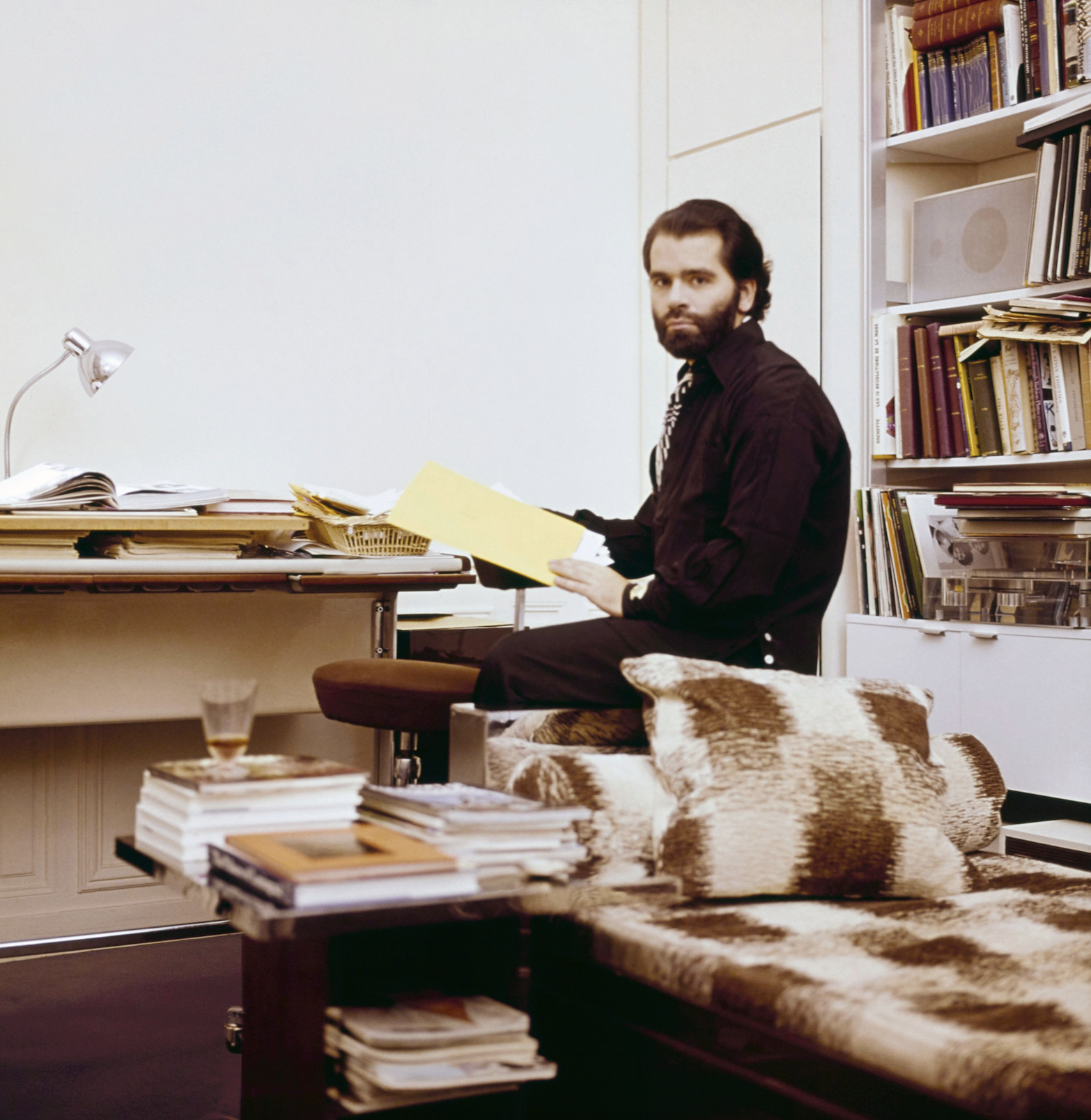
Lagerfeld’s increasing fame and financial success allowed him to indulge in an unprecedented spending frenzy, competing with deep-pocketed institutions like the Louvre to acquire the finest, most pedigreed pearls of the era—voluptuously carved and gilded bergères; ormolu chests; and fleshy, pastel-tinged Fragonard idylls—to adorn his urban palace. His one-time friend André Leon Talley described him in a contemporary article as suffering from “Versailles complex”.
However, in mid-1981, and in response to the election of left-wing president, François Mitterrand, Lagerfeld, with the assistance of his close friend Princess Caroline, became a resident of the tax haven of Monaco. He purchased two apartments on the 21st floor of Le Roccabella, a luxury residential block designed by Gio Ponti. One, in which he kept Jacques de Bascher, with whom he was now reconciled, was decorated in the strict, monochromatic Viennese Secessionist style that had long underpinned his aesthetic vocabulary; the other space, though, was something else entirely, cementing his notoriety as an iconoclastic tastemaker.
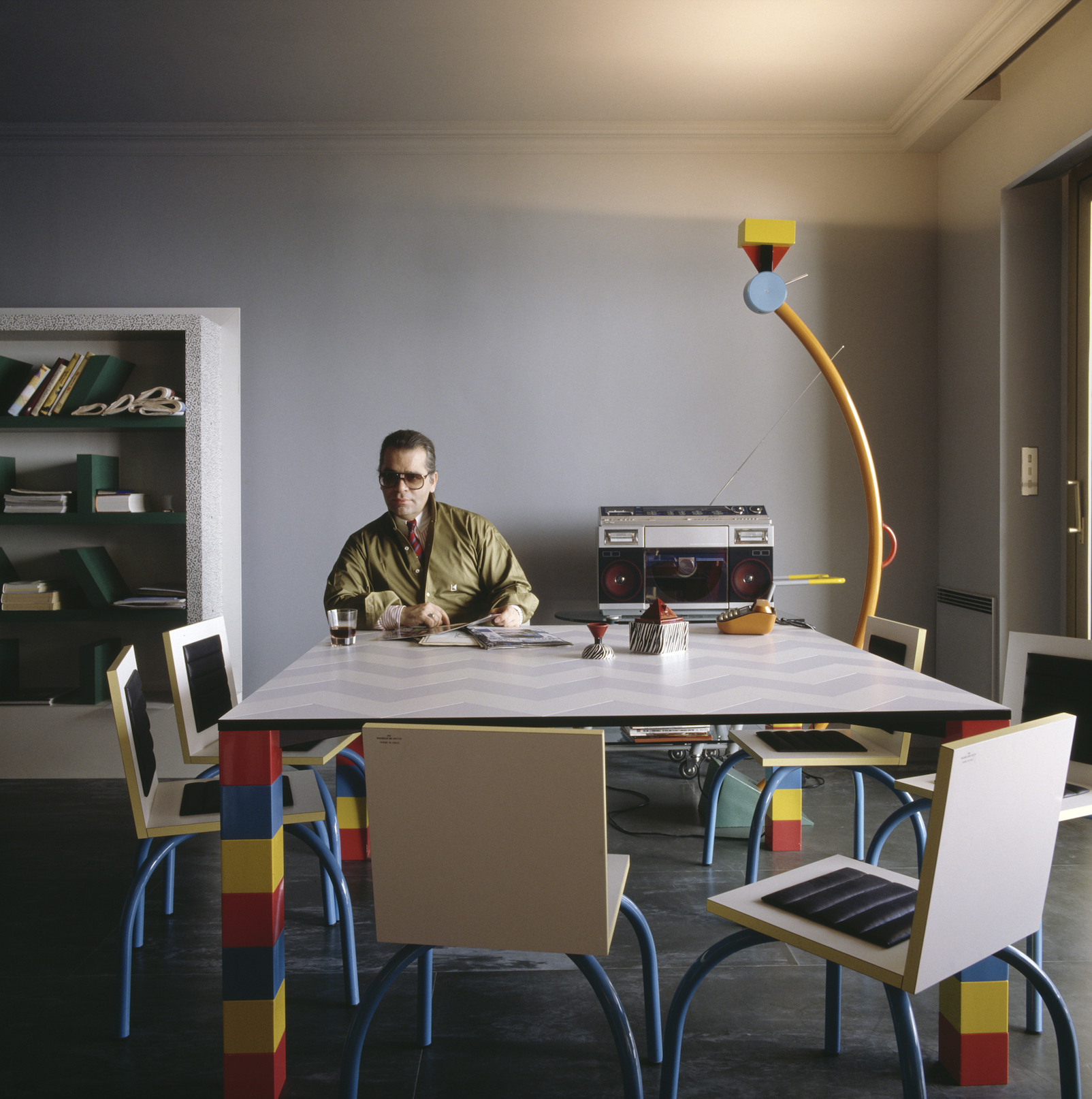
Lagerfeld had recently discovered the radically quirky designs of the Memphis Group led by Ettore Sottsass, and bought the collective’s entire first collection and had it shipped to Monaco. In a space with no right angles, these chaotically colourful, geometrically askew pieces—centred on Masanori Umeda’s famous boxing ring—gave visitors the disorientating sensation of having entered a corporeal comic strip. By 1991, the novelty of this jarring postmodern playhouse had inevitably worn thin and once again he sent it all to auction, later telling a journalist that “after a few years it was like living in an old Courrèges. Ha!”

In 1989, de Bascher died of an AIDS-related illness, and while Lagerfeld’s career continued to flourish, emotionally the famously stoic designer was struggling. In 2000, a somewhat corpulent Lagerfeld officially ended his “let them eat cake” years at the Hôtel Pozzo di Borgo, selling its sumptuous antique fittings in a massive headline auction that stretched over three days. As always there were other houses, but now with his longtime companion dead, and his celebrity metastasising making him a target for the paparazzi, he began to look less for exhibition spaces and more for private sanctuaries where he could pursue his endless, often lonely, work.
His next significant house was Villa Jako, named for his lost companion and built in the 1920s in a nouveau riche area of Hamburg close to where he grew up. Lagerfeld shot the advertising campaign for Lagerfeld Jako there—a fragrance created in memorial to de Bascher. The house featured a collection of mainly Scandinavian antiques, marking the aesthetic cusp between Art Nouveau and Art Deco. One of its rooms Lagerfeld decorated based on his remembrances of his childhood nursery. Here, he locked himself away to work—tellingly—on a series of illustrations for the fairy tale, The Emperor’s New Clothes. Villa Jako was a house of deep nostalgia and mourning.
But there were more acts—and more houses—to come in Lagerfeld’s life yet. In November 2000, upon seeing the attenuated tailoring of Hedi Slimane, then head of menswear at Christian Dior, the 135 kg Lagerfeld embarked on a strict dietary regime. Over the next 13 months, he melted into a shadow of his former self. It is this incarnation of Lagerfeld—high white starched collars; Slimane’s skintight suits, and fingerless leather gloves revealing hands bedecked with heavy silver rings—that is immediately recognisable some five years after his death.
The 200-year-old apartment in Quái Voltaire, Paris, was purchased in 2006, and after years of slumber Lagerfeld—a newly awakened Hip Van Winkle—was ready to remake it into his last modernist masterpiece. He designed a unique daylight simulation system that meant the monochromatic space was completely without shadows—and without memory. The walls were frosted and smoked glass, the floors concrete and silicone; and any hint of texture was banned with only shiny, sleek pieces by Marc Newson, Martin Szekely and the Bouroullec Brothers permitted. Few guests were allowed into this monastic environment where Lagerfeld worked, drank endless cans of Diet Coke and communed with Choupette, his beloved Birman cat, and parts of his collection of 300,000 books—one of the largest private collections in the world.
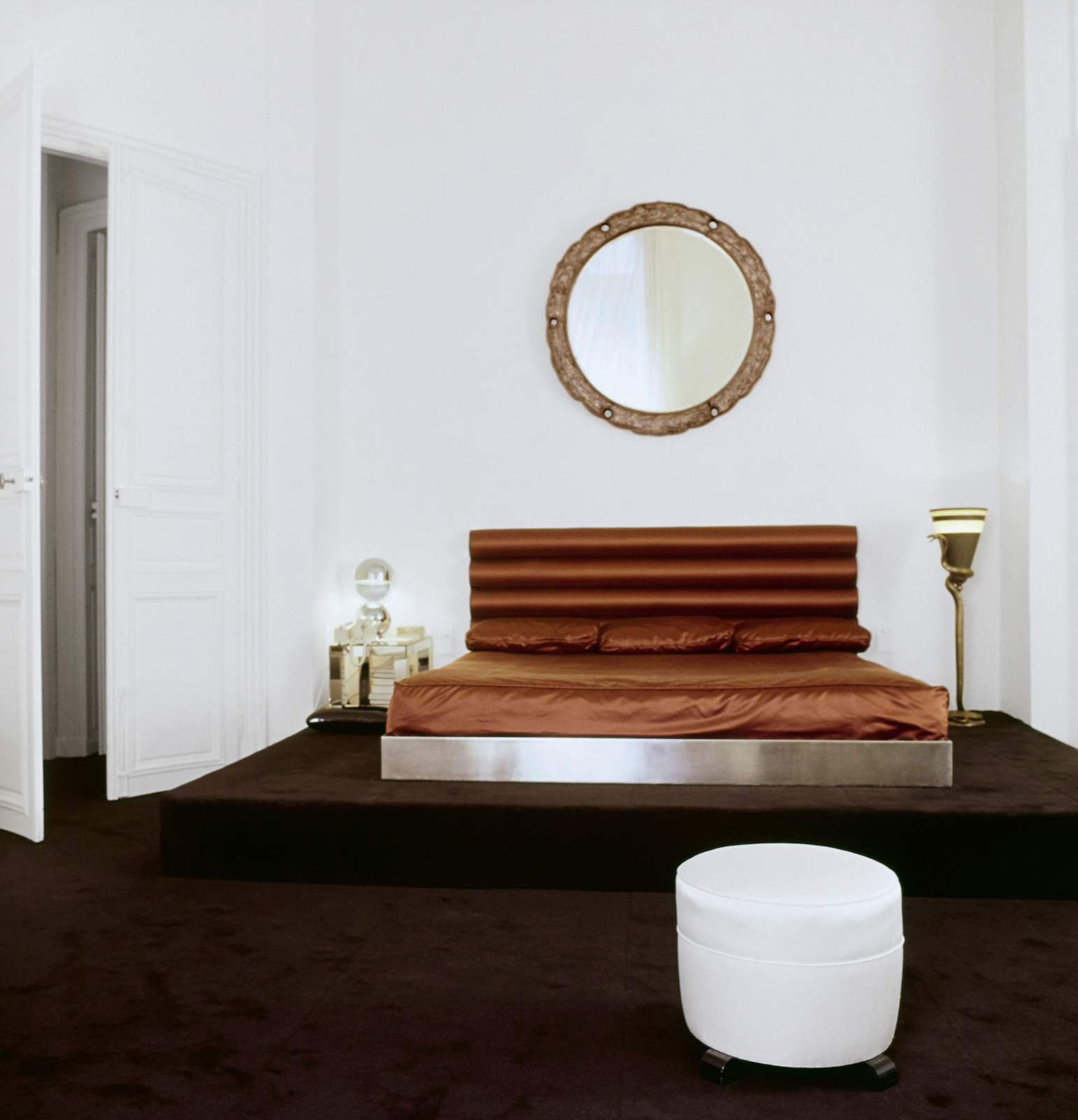
Lagerfeld died in 2019, and the process of dispersing his worldly goods is still ongoing. The Quái Voltaire apartment was sold this year for US$10.8 million (around $16.3 million). Now only the rue de Saint-Peres property remains within the Lagerfeld trust. Purchased after Quái Voltaire to further accommodate more of his books—35,000 were displayed in his studio alone, always stacked horizontally so he could read the titles without straining his neck—and as a place for food preparation as he loathed his primary living space having any trace of cooking smells. Today, the rue de Saint-Peres residence is open to the public as an arts performance space and most fittingly, a library.
You may also like.
By Josh Bozin
24/07/2024
Watch This Space: Mike Nouveau
Meet the game-changing horological influencers blazing a trail across social media—and doing things their own way.
In the thriving world of luxury watches, few people own a space that offers unfiltered digital amplification. And that’s precisely what makes the likes of Brynn Wallner, Teddy Baldassarre, Mike Nouveau and Justin Hast so compelling.
These thought-provoking digital crusaders are now paving the way for the story of watches to be told, and shown, in a new light. Speaking to thousands of followers on the daily—mainly via TikTok, Instagram and YouTube—these progressive commentators represent the new guard of watch pundits. And they’re swaying the opinions, and dollars, of the up-and-coming generations who now represent the target consumer of this booming sector.
—
MIKE NOUVEAU

Can we please see what’s on the wrist? That’s the question that catapulted Mike Nouveau into watch stardom, thanks to his penchant for highlighting incredibly rare timepieces across his TikTok account of more than 400,000 followers. When viewing Nouveau’s attention-grabbing video clips—usually shot in a New York City neighbourhood—it’s not uncommon to find him wrist-rolling some of the world’s rarest timepieces, like the million-dollar Cartier Cheich (a clip he posted in May).
But how did someone without any previous watch experience come to amass such a cult following, and in the process gain access to some of the world’s most coveted timepieces? Nouveau admits had been a collector for many years, but moved didn’t move into horology full-time until 2020, when he swapped his DJing career for one as a vintage watch specialist.
“I probably researched for a year before I even bought my first watch,” says Nouveau, alluding to his Rolex GMT Master “Pepsi” ref. 1675 from 1967, a lionised timepiece in the vintage cosmos. “I would see deals arise that I knew were very good, but they weren’t necessarily watches that I wanted to buy myself. I eventually started buying and selling, flipping just for fun because I knew how to spot a good deal.”
Nouveau claims that before launching his TikTok account in the wake of Covid-19, no one in the watch community knew he existed. “There really wasn’t much watch content, if any, on TikTok before I started posting, especially talking about vintage watches. There’s still not that many voices for vintage watches, period,” says Nouveau. “It just so happens that my audience probably skews younger, and I’d say there are just as many young people interested in vintage watches as there are in modern watches.”
View this post on Instagram
Nouveau recently posted a video to his TikTok account revealing that the average price of a watch purchased by Gen Z is now almost US$11,000 (around $16,500), with 41 percent of them coming into possession of a luxury watch in the past 12 months.
“Do as much independent research as you can [when buying],” he advises. “The more you do, the more informed you are and the less likely you are to make a mistake. And don’t bring modern watch expectations to the vintage world because it’s very different. People say, ‘buy the dealer’, but I don’t do that. I trust myself and myself only.”
—
Read more about the influencers shaking up horology here with Justin Hast, Brynn Wallner and Teddy Baldassare.
You may also like.
By Josh Bozin
24/07/2024
This Pristine 1960 Ferrari 250 Spider Could Fetch $24 Million at Auction
The car wears the same colours and has the same engine it left the factory with.
Some Ferraris are just a little bit more important than others.
Take, for example, the 1960 250 GT SWB California that RM Sotheby’s is auctioning off during this year’s Monterey Car Week. Any example of the open-top beauty would attract interest, but this one just so happens to be the first one that was built.
The 250 is one of the most legendary series of cars in Ferrari history. Between 1952 and 1964, the company released 21 different 250 models—seven for racetracks, 14 for public roads—of which the “Cali Spider” might be the most well regarded, thanks to its potent V-12 and a Pininfarina-penned design that is one of the most beautiful bodies to grace an automobile. The roadster, which was specifically built for the U.S., made its debut in 1957 as a long-wheel-base model (LWB), but it wasn’t until the SWB model debut in 1960 that it became clear how special it was. This example isn’t just the first to roll off the line. It’s the actual car that was used to introduce the world to the model at the 1960 Geneva Motor Show.
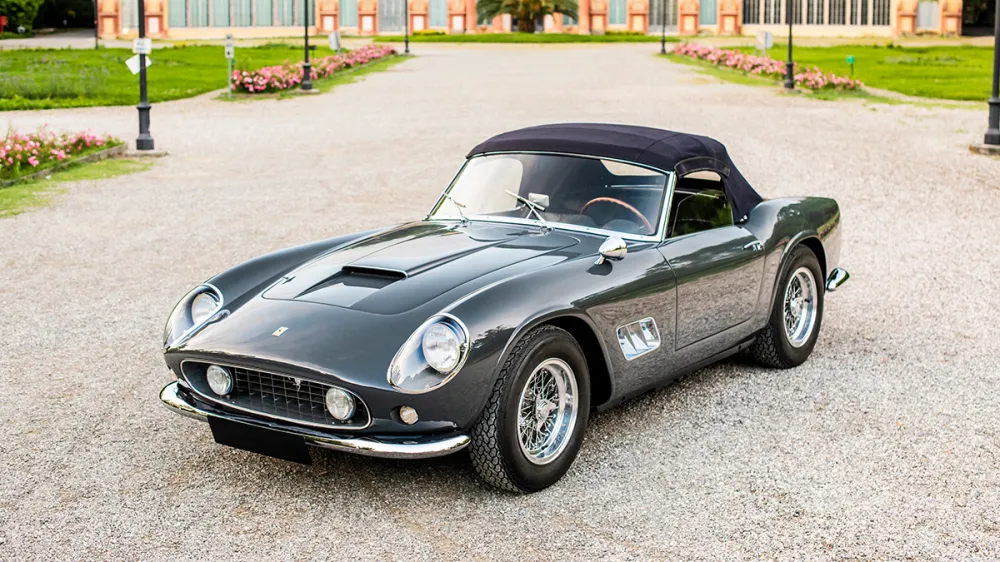
Just 56 examples of the 250 GT SWB California Spider would be built by Scaglietti during the three years it was in production. The first of those, chassis 1795 GT, is finished in a glossy coat of Grigio. The two-door had a red leather interior at Geneva but was returned to the factory and re-outfitted with black leather upholstery before being delivered to its original owner, British race car driver John Gordon Bennet. Six-and-a-half decades later the car looks identical to how it did when it left the factory the second time.
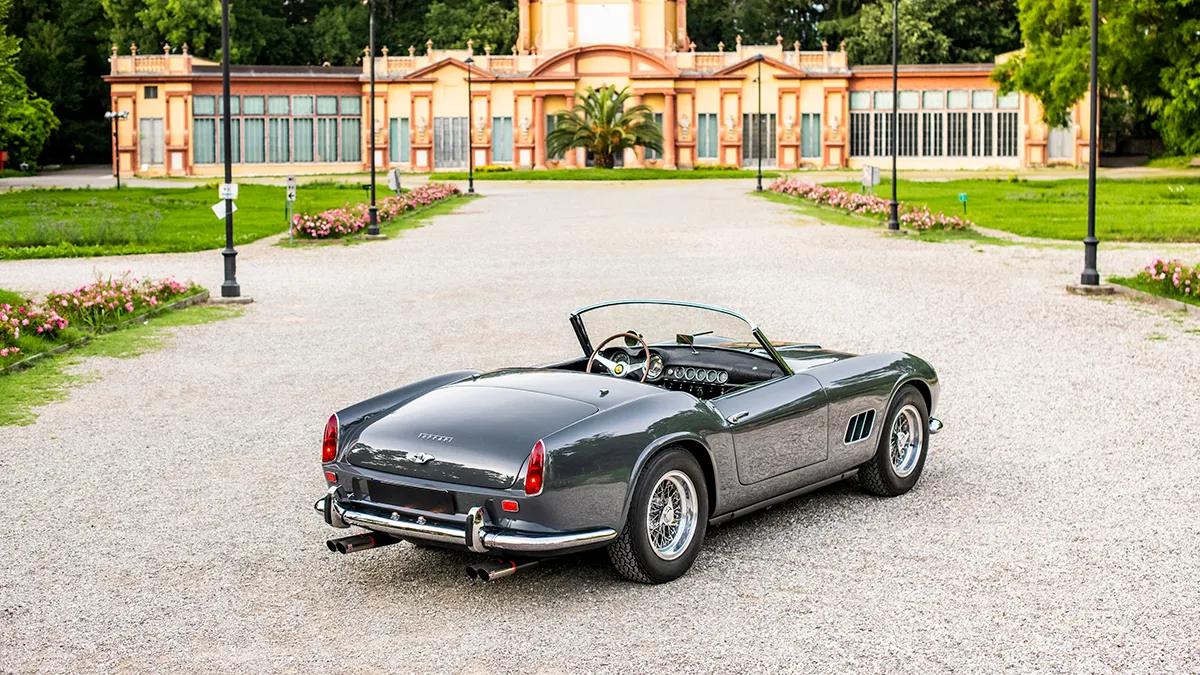
In addition to its original bodywork, the chassis 1795 GT features its original engine, gearbox, and rear axle. That mill is the competition-spec Tipo 168, a 3.0-litre V-12 that makes 196.1 kW. That may not sound like much by today’s standards, but, when you consider that the 250 GT SWB California Spider tips the scales around 952 kilograms, it’s more than enough.
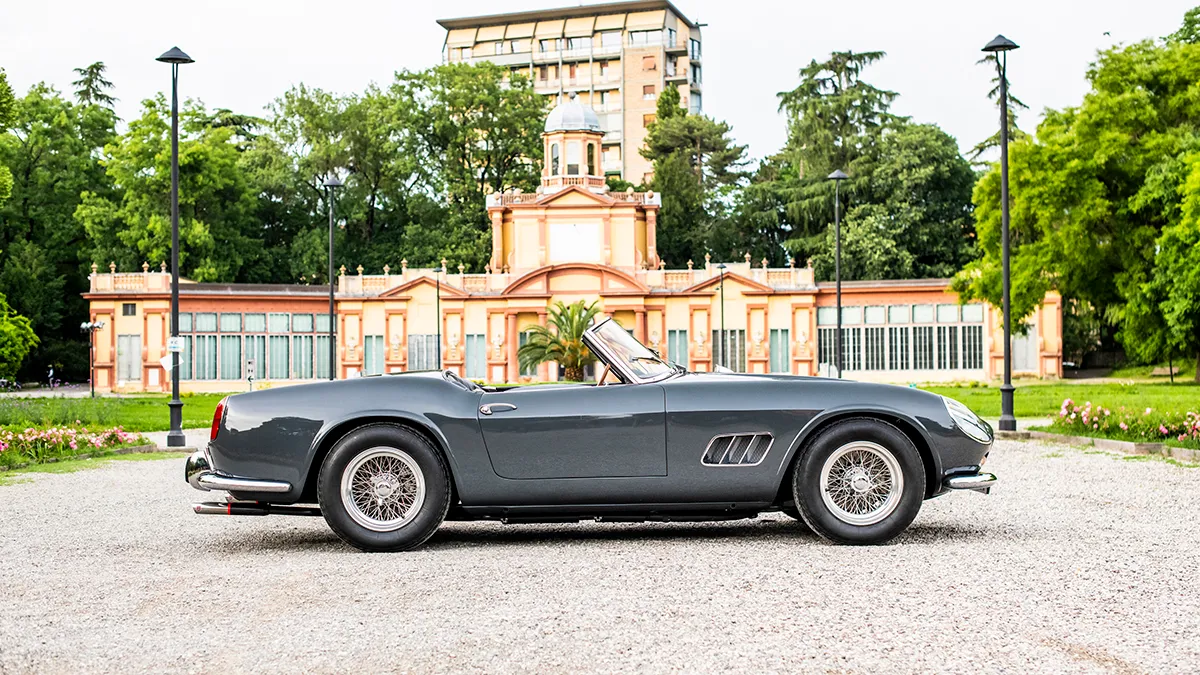
The first 250 GT SWB California Spider is scheduled to go up for bid during RM Sotheby’s annual Monterey Car Week auction, which runs from Thursday, August 15, to Saturday, August 17. Unsurprisingly, the house has quite high hopes for the car. The car carries an estimate of between $24 million and $26 million, which could make it one of the most expensive cars ever sold at auction.
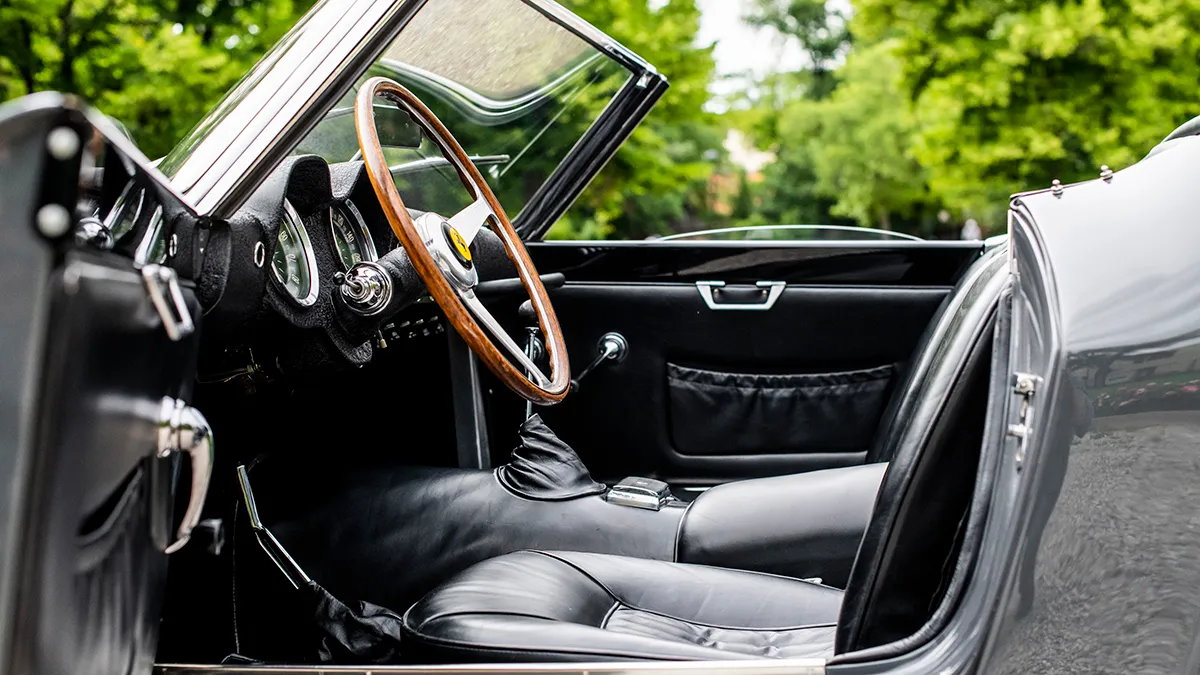
You may also like.
By Josh Bozin
24/07/2024






